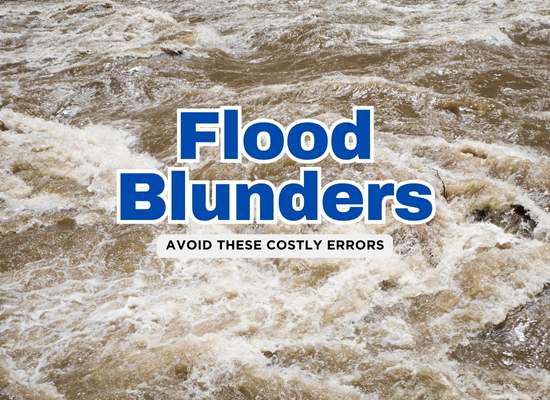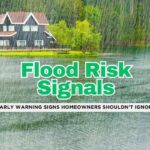Floods can strike with little warning, turning homes and businesses into disaster zones within hours. While many people believe they’re prepared, small oversights and common misconceptions can lead to devastating consequences. From failing to evacuate in time to relying on ineffective flood barriers, these mistakes can cost thousands in damages—or worse, put lives at risk. Here are 20 of the biggest mistakes people make when preparing for floods.
1️⃣ Underestimating the Risk
Many people believe that if they haven’t experienced flooding before, it won’t happen to them. This false sense of security leads to a lack of preparation and, in some cases, refusal to evacuate when warnings are issued.
Why This Is a Costly Mistake
Flood zones change over time due to development, deforestation, and climate patterns. Even areas with no prior flood history can suddenly become high-risk. Ignoring the possibility of flooding often means missing crucial preparation steps, leaving homes and belongings vulnerable.
What to Do Instead
Check FEMA flood maps or local government resources to understand your flood risk. If you live near a river, coast, or low-lying area, assume that flooding is a possibility and take preventative measures, even if you’ve never seen high water before.
2️⃣ Not Having an Emergency Plan
Many households wait until floodwaters are rising before deciding how to respond. This last-minute scrambling leads to panic, poor decision-making, and a higher chance of getting stranded.
Why This Puts You in Danger
Without a plan, you may waste precious time figuring out evacuation routes, gathering supplies, or deciding where to go. Roads can become impassable within minutes, and emergency responders may be too overwhelmed to assist everyone.
What to Do Instead
Create a detailed flood emergency plan that includes:
- Evacuation routes and multiple backup paths
- A designated meeting place for family members
- A communication plan in case phone service goes down
- A list of essential items to grab before leaving
Practice the plan with your household so that when the time comes, everyone knows exactly what to do.
3️⃣ Waiting Too Long to Evacuate
One of the most dangerous flood-related mistakes is delaying evacuation. Many people assume they can wait until the water starts rising before leaving, but by then, roads may already be impassable.
Why This Decision Can Be Fatal
Flash floods can develop within minutes, and even slow-rising floods can cut off escape routes before you realize it. Vehicles can be swept away in just 12 inches of moving water, and floodwaters often contain hidden debris and strong currents.
What to Do Instead
If officials issue an evacuation order, leave immediately. Even if evacuation is only recommended and not mandatory, it’s better to be safe than trapped. Plan ahead by knowing multiple exit routes and keeping a go-bag ready.
4️⃣ Relying Solely on Sandbags for Protection
Sandbags are a common go-to for flood prevention, but they are far from foolproof. Many homeowners believe that stacking sandbags around their doors and foundations will keep water out, only to find their homes still flooding.
Why Sandbags Aren’t Enough
- They absorb water over time, becoming ineffective.
- They don’t seal completely, allowing water to seep through gaps.
- They can be washed away by strong currents.
- They require proper stacking techniques to be somewhat effective, which many people don’t know.
What to Do Instead
Consider modern flood barriers, such as:
- Water-filled flood tubes that create a stronger barrier
- Flood shields that attach to doors and windows
- Hydrophobic flood bags that expand and form watertight seals
If you do use sandbags, combine them with plastic sheeting and proper stacking techniques to improve their effectiveness.
5️⃣ Forgetting to Elevate Important Items
Many homeowners focus on stopping floodwaters from entering their home but forget to protect valuables and essential items inside. Electronics, important documents, and furniture left at floor level can be easily damaged or destroyed.
Why This Leads to Major Losses
Even a few inches of water can ruin appliances, short-circuit electrical systems, and soak irreplaceable items. Once floodwaters recede, mold and bacteria can make anything left in the water hazardous to keep.
What to Do Instead
Move important belongings, including electronics, important paperwork, and sentimental items, to higher floors or shelves. Elevate appliances like water heaters and electrical panels if possible. Use waterproof containers to store documents, insurance policies, and emergency cash.
6️⃣ Assuming Flood Insurance Covers Everything
Many people believe that their standard homeowner’s insurance policy includes flood coverage, only to find out too late that it doesn’t. Others assume that having flood insurance means they’re fully covered, without understanding the exclusions and waiting periods.
Why This Leads to Financial Disaster
Most standard homeowner’s policies do not cover flood damage. Even when purchasing a separate flood insurance policy, there is usually a 30-day waiting period before coverage kicks in. Some policies also have exclusions for certain types of water damage, leaving homeowners to pay out of pocket.
What to Do Instead
Review your insurance policies well in advance of flood season. If you need flood coverage, buy it early to account for the waiting period. Make sure you understand what is and isn’t covered, including contents, basement flooding, and temporary housing costs.
7️⃣ Not Clearing Gutters, Drains, and Downspouts
Blocked drainage systems can make flooding significantly worse by preventing water from flowing away from your home. Many people forget to check gutters, downspouts, and street drains before heavy rainfall, allowing water to back up and pool around their property.
Why This Increases Flood Risk
When gutters and drains are clogged with leaves, dirt, or debris, water has nowhere to go and can seep into basements, overwhelm sump pumps, and cause localized flooding even in areas with minimal rainfall.
What to Do Instead
Regularly clean gutters and downspouts, especially before storm season. Make sure drains near your home are clear of debris and that sump pumps are tested and working properly. Consider installing gutter guards to reduce buildup and keep water flowing freely.
8️⃣ Storing Hazardous Materials Where Floodwaters Can Reach Them
Floods don’t just bring in water—they can also spread dangerous chemicals, fuel, and waste if hazardous materials aren’t stored properly. Many homeowners keep paints, gasoline, pesticides, and cleaning chemicals in low-lying areas like basements and garages, putting them at risk of contamination.
Why This Poses a Health and Environmental Risk
Floodwaters can mix with chemicals, creating toxic water that spreads throughout homes and neighborhoods. This can cause serious health issues, contaminate water supplies, and make cleanup far more difficult and dangerous.
What to Do Instead
Store hazardous materials on high shelves or in waterproof containers. If you live in a flood-prone area, consider moving flammable or toxic substances to an outbuilding or shed on higher ground. During flood warnings, secure all chemicals in sealed, labeled containers to prevent leaks.
9️⃣ Ignoring Evacuation Routes and Road Closures
Many people assume they can drive their usual routes during a flood, only to find roads blocked or underwater. Relying on GPS alone can also be a mistake, as it may not update in real time to reflect flooded areas.
Why This Puts Lives at Risk
Floodwaters can wash away roads, create sinkholes, or make bridges unstable. Driving through even a few inches of moving water can cause vehicles to lose control, while deeper water can stall engines or sweep cars away.
What to Do Instead
Before flood season, familiarize yourself with multiple evacuation routes. Keep a battery-powered radio or emergency app handy to receive real-time road closure updates. If you encounter standing water, remember the rule: Turn around, don’t drown.
1️⃣0️⃣ Forgetting About Pets in Evacuation Plans
Many people make detailed flood evacuation plans but forget to account for their pets. This oversight can lead to last-minute scrambling, putting both animals and owners at risk.
Why This Causes Problems
Not all shelters accept pets, and floodwaters can rise quickly, leaving little time to secure their safety. Some pet owners are forced to leave their animals behind, assuming they’ll be fine, only to find them injured or lost after the disaster.
What to Do Instead
Include pets in all evacuation plans. Pack a pet emergency kit with food, water, medication, and a carrier or leash. Research pet-friendly shelters or hotels in advance, and never assume that your pet will be safe if left behind.
1️⃣1️⃣ Leaving Vehicles in Low-Lying Areas
Parking vehicles in a driveway, street, or underground garage during heavy rain can result in complete loss if floodwaters rise unexpectedly. Many people forget to move their cars until it’s too late.
Why This Leads to Costly Damage
Even a few inches of floodwater can destroy a vehicle’s electrical system and interior. Flooded cars are often considered total losses by insurance companies, leaving owners to deal with expensive replacements.
What to Do Instead
When a flood warning is issued, move your vehicle to higher ground. If you have a multi-story parking garage nearby, use it as a safe spot. If leaving your car behind, disconnect the battery to prevent electrical damage.
1️⃣2️⃣ Not Backing Up Important Documents Digitally
Many people store birth certificates, insurance policies, home deeds, and other critical paperwork in filing cabinets or safes, assuming they are safe from flood damage.
Why This Can Be a Major Setback
Water can ruin paper documents beyond recovery, and even fireproof safes may not be fully waterproof. Losing these documents can make post-flood recovery and insurance claims significantly harder.
What to Do Instead
Scan and store important documents digitally on a secure cloud service or an encrypted USB drive. Keep physical copies in waterproof, portable containers that can be easily grabbed during an evacuation.
1️⃣3️⃣ Overlooking Basement Floodproofing
Many homeowners assume their basement will stay dry if they don’t live in a flood zone, but heavy rains and rising groundwater can cause severe basement flooding even in areas with low flood risk.
Why This Leads to Major Water Damage
Basements are naturally prone to flooding due to their low elevation. Without proper waterproofing, water can seep through cracks in the foundation, overwhelm drains, or back up through sump pump failures.
What to Do Instead
Seal foundation cracks, install a battery backup for your sump pump, and consider adding a French drain system. If flooding is common, elevate appliances like furnaces and water heaters to reduce potential damage.
1️⃣4️⃣ Assuming Tap Water Will Stay Safe to Drink
Many people don’t realize that floodwaters can contaminate municipal water supplies, making tap water unsafe to drink even if their home isn’t directly affected.
Why This Is a Health Hazard
Floods can overwhelm water treatment plants, introduce bacteria and chemicals into the water supply, and cause sewer backups. Drinking or cooking with contaminated water can lead to serious illness.
What to Do Instead
Have a supply of bottled water on hand before flood season. After a flood, listen for boil water advisories from local authorities before using tap water for drinking, brushing teeth, or cooking.
1️⃣5️⃣ Relying on Homeowner’s Insurance for Flood Damage
A major misconception is that standard homeowner’s insurance policies cover flood damage. Many people don’t realize they need a separate flood insurance policy until they file a claim and get denied.
Why This Becomes a Costly Mistake
Flood damage is typically excluded from standard policies, leaving homeowners to cover repairs and replacements out of pocket. Without flood insurance, even minor flooding can result in tens of thousands of dollars in losses.
What to Do Instead
Check your policy well before flood season and, if needed, purchase flood insurance through the National Flood Insurance Program (NFIP) or private insurers. Since most policies have a 30-day waiting period, don’t wait until a storm is on the horizon to get coverage.
1️⃣6️⃣ Not Testing Backup Power Sources
Some homeowners invest in a generator or battery backup system for power outages but forget to test them regularly. When a flood knocks out electricity, they’re left scrambling with equipment that won’t start.
Why This Leads to Big Problems
Floods often come with high winds and heavy rain, causing widespread power failures. Without backup power, sump pumps, refrigerators, and essential medical devices may stop working at the worst possible time.
What to Do Instead
Test generators and battery backups at least once a month. Keep extra fuel or fully charged batteries on hand, and never run a generator indoors due to carbon monoxide risks.
1️⃣7️⃣ Storing Belongings in Cardboard Boxes
Many people store important items, seasonal decorations, and keepsakes in cardboard boxes, assuming they are safely tucked away in garages, closets, or basements. But when floodwaters rise, cardboard provides no protection.
Why This Leads to Ruined Possessions
Cardboard absorbs water quickly, causing boxes to collapse and leaving belongings soaked, moldy, or permanently damaged. Even minor flooding can destroy irreplaceable family heirlooms, electronics, and documents.
What to Do Instead
Store important items in waterproof plastic bins with secure lids. If possible, keep bins off the ground on elevated shelves or in attic spaces where floodwaters are less likely to reach.
1️⃣8️⃣ Not Knowing How to Shut Off Utilities
Many homeowners don’t think about shutting off their water, gas, or electricity until it’s too late, increasing the risk of fires, gas leaks, and electrical hazards.
Why This Can Be Extremely Dangerous
Floodwaters can cause electrical shorts, lead to gas leaks, or contaminate plumbing systems. If utilities aren’t shut off before the worst of the flooding, emergency responders may not be able to reach you in time to prevent further damage.
What to Do Instead
Learn where your main electrical panel, gas valve, and water shut-off are located. If a flood is imminent, turn off power at the breaker and shut off gas and water lines to prevent further damage or safety hazards.
1️⃣9️⃣ Assuming Roads Will Be Open After the Flood
After the worst of the flooding has passed, many people try to return home immediately, assuming roads and bridges will be safe. However, post-flood conditions can be just as dangerous as the initial disaster.
Why This Is a Risky Mistake
Floodwaters can weaken bridges, wash out roads, or leave behind mudslides and sinkholes. Even if roads look clear, structural damage may not be visible, making travel extremely hazardous.
What to Do Instead
Check local emergency updates and avoid flooded areas even after water has receded. Use official sources to confirm when roads and bridges have been inspected and deemed safe.
2️⃣0️⃣ Failing to Document Damage for Insurance Claims
After a flood, many people rush to clean up and throw away ruined belongings without properly documenting the damage. This makes it harder to file successful insurance claims.
Why This Leads to Denied or Reduced Claims
Insurance companies require detailed proof of flood damage, including photos and an inventory of losses. Without proper documentation, homeowners may struggle to get the full compensation they’re entitled to.
What to Do Instead
Before cleaning anything, take clear, detailed photos of all flood damage, including walls, flooring, furniture, and electronics. Keep receipts for any emergency repairs or purchases and work with an adjuster to ensure a thorough damage assessment.
Preparing for a flood isn’t just about stacking sandbags or stocking up on bottled water. Avoiding these common mistakes can mean the difference between minor inconvenience and major disaster. By planning ahead, securing the right insurance, and taking proactive steps, you can significantly reduce your risk and ensure a smoother recovery if a flood does occur.
Don’t wait until the water is rising—start preparing now so you can stay ahead of the storm.



